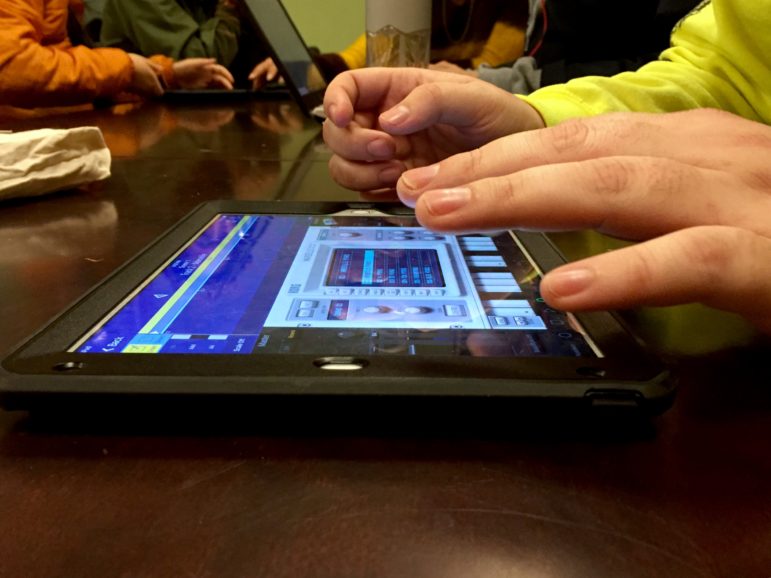
Giulia Hjort
Students in the program had access to iPads equipped with free or low-cost audio mixing software.
Hip-hop samples and ambient beats resonated through the auditorium at the Abrons Arts Center on the Lower East Side. Dec. 11, as graduates of the electronic music production workshop at The Loisaida Center showcased their self-produced mixes to a packed audience of local art supporters.
The students, ranging in age between 17 and 24, were part of the Loisaida’s media and technology hub, El Semillero, or The Seedbed. The hub was funded by a capital grant from former Councilwoman Rosie Mendez and the economic development organization, Acacia Network, with additional support from a $16,950 grant from the city’s Cultural Development Fund to encourage the participation of Latino youths in the cultural life of the neighborhood.
Meeting every Tuesday night for 10 weeks, the students practiced beat making. They had access to iPads equipped with free or low-cost audio mixing software, made possible through a first-time, subsidized collaboration between Loisaida, Abrons and Sonic Arts for All.
Sara Skolnick, 32, an arts educator and DJ who uses the moniker Riobamba, headed the workshop. As a first-generation Ecuadorian, Skolnick said she recognizes the importance of creating spaces for communities of color in electronic music, inaccessible to many because of prohibitive studio and equipment costs.
“It’s important to elevate Latinx and other cultures present in the Lower East Side through art,” said Skolnick. She said the program was also a way to create more opportunities for people of color in the wider art world. “Think about equity and what tools we can make accessible to provide pathways to entrepreneurship and employment,” she said.
Access to consuming and creating art in New York City is a growing concern. In a 2016 citywide study, researchers at the University of Pennsylvania found that low-income neighborhoods and communities of color, mostly in Brooklyn and the Bronx, had significantly fewer cultural resources in comparison to higher-income neighborhoods.
CreateNYC is the Department of Cultural Affairs’ 10-year plan to increase diversity, equity and inclusion in the arts. It reflects suggestions from nearly 200,000 New Yorkers and cultural institutions on how to best allocate the city’s cultural budget of $198.4 million for fiscal year 2019, a $21.4 million increase from 2017.
Loisaida’s role as one of the only remaining community spaces providing cultural programming to the dwindling population of Latinx and people of color on the Lower East Side helped make it one of the institutions chosen to advise the city on the best way to allocate $43.9 million in grants earmarked for 977 local cultural organizations throughout the five boroughs.
Andrea Gordillo, program outreach manager at Loisaida, sees the cultural plan as an opportunity to address the Lower East Side’s affordability crisis, a condition that has fast tracked residential displacement and cultural erasure in the neighborhood.
“Loisaida represents the working class and the historic Puerto Rican and Latinx of the Lower East Side,” says Gordillo. “We need to put pressure on the infrastructure of cultural funding to make it more equitable for these populations.”
She said El Semillero’s electronic music production workshop is an example of the successful democratization of technology and nurturing of local talent that is overwhelmingly granted to large arts institutions such as those belonging to the Cultural Institutions Group. Loisaida recommends that Cultural Affairs adopt similar workshops across the boroughs.
Workshop participant and graphic designer, Gian Campos, 24, had little prior knowledge of sound production. But after the 10-week introductory course, Campos was inspired to continue producing and mixing beats.
“Creativity is one thing you can’t outsource or automate,” said Campos. “It’s important to cultivate these talents within our communities.”
City Limits’ reporting on the intersection of art and policy is supported by the Laurie M. Tisch Illumination Fund. City Limits is solely responsible for all content.








